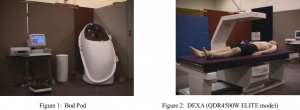Kenric L. Russell and Dr. Larry Tucker, Physical Education
People with excess weight, and especially excess body fat, have an increased risk for many health problems. These problems include heart disease, hypercholesterolemia, hypertension, increased morbidity and mortality from diabetes, and cancer. The National Center for Health Statistics recently reported that 33% of Americans are overweight.
By quantifying the amount of adipose tissue in the body, important information about the health status of adults can be obtained. Body mass index (BMI) and height/weight charts are two traditional methods of estimating body mass in adults. One major drawback of both BMI and height/weight charts, however, is that they tend to label muscular individuals as obese. The increased weight in these individuals is muscle, not adipose tissue.
Excessive body fat, instead of excess body weight, is now the definition of obesity. A person’s body fat percent (BF%) is indexed as the percentage of fat mass in a person’s body. Several methods exist for measuring an individual’s BF%. Skinfolds, bioelectrical impedance, hydrostatic weighing, and the Bod Pod are the most commonly used methods.
Recently, a new method of measuring BF% has been developed, known as DEXA. Duel Energy XRay Absorptiometry (DEXA) was developed by Hologic Inc. (Waltham, MA) as a method of measuring bone density using alternating high and low energy X-rays. DEXA is now viewed as the most precise method available for measuring body composition. The basic principle of DEXA data acquisition is based on different bone and soft tissue attenuation characteristics at the two X-ray levels. As the X-ray beam passes through the subject, more low energy X-rays than high energy X-rays are absorbed by the subject’s anatomical structures. Detectors then register the X-ray beam. The raw scan data, containing the attenuation values of tissue and bone, are relayed to a computer. An algorithm interprets each pixel, creates an image and quantitative measurement of the bone and body tissues.
Another method of measuring body composition assessment, the Bod Pod (Life Measurement Instruments, Concord, CA), was developed about five years ago. This system utilizes the inverse relationship between pressure (P) and volume (V) [Boyle’s law: P1V1=P2V2] to determine body volume (Vb). Once Vb is ascertained, the principles of densiometry are used to determine body composition (BF%) from body density (Db=mass/volume).
Although the Bod Pod method is less expensive and is less invasive to subjects, DEXA seems to have many advantages. Instead of using an equation to estimate body composition, DEXA measures body composition directly from reflected X-ray particles. DEXA not only measures BF%, but also total bone density. DEXA also measures bone density at any given location on the subject. By using the DEXA method, a subject’s body composition can also be segmented into a variety of regions, including forearm, hip, chest, head, and legs.
A total of 100 middle-age women were used as subjects (mean age = 40 years). Each subject signed an informed consent document before participating in the study.
To determine BF% using the Bod Pod, subjects were asked to sit in the Bod Pod chamber (Fig. 1), breathe normally, and hold completely still. The system utilized the inverse relationship between pressure (P) and volume (V) [Boyle’s law: P1V1=P2V2] to ascertain body volume (Vb). Once Vb was calculated, the Bod Pod computer used Siri’s equation to determine BF% from body density (Db=mass/volume). During a 30 second period in the chamber, subjects were required to breathe through a filtered tube in order for lung volume to be calculated. Multiple assessments within the Bod Pod usually required less than 10 minutes.
To perform the DEXA method, subjects were asked to lie on the examining table in a supine position (Fig. 2). They were centered on the table with their hands to the side. Their feet and legs were slightly internally rotated, being held in position with athletic tape. The first scan took six minutes, after which subjects were asked to remove themselves from the table and move around. After a short break, the subjects were asked to again lie on the table, and the process was then repeated a second time.
Results showed that the mean BF% for the Bod Pod was 30.78 + 7.92 and 30.35 + 7.32 for DEXA (mean difference = 0.43 + 2.76; p > 0.05). The mean of the sum of the absolute value of the differences between the DEXA and Bod Pod results was 2.06. A total of 85% of the subjects had a mean difference between their Bod Pod and DEXA results of < 4% points; 77% had a difference of < 3% points; 63% had a mean difference of < 2% points; and 35% had a mean difference between the two measures of < 1% point. The Pearson correlation between the Bod Pod and DEXA BF% results was 0.94 (p<0.001) and the intraclass correlation was 0.97 (p<0.001). When a regression equation was generated using Bod Pod results to predict DEXA results, the standard error of estimate (SEE) was 2.5%.
Apparently, the Bod Pod and DEXA methods produce statistically equal BF% results with most subjects showing less then 2% points difference between the two assessments.

